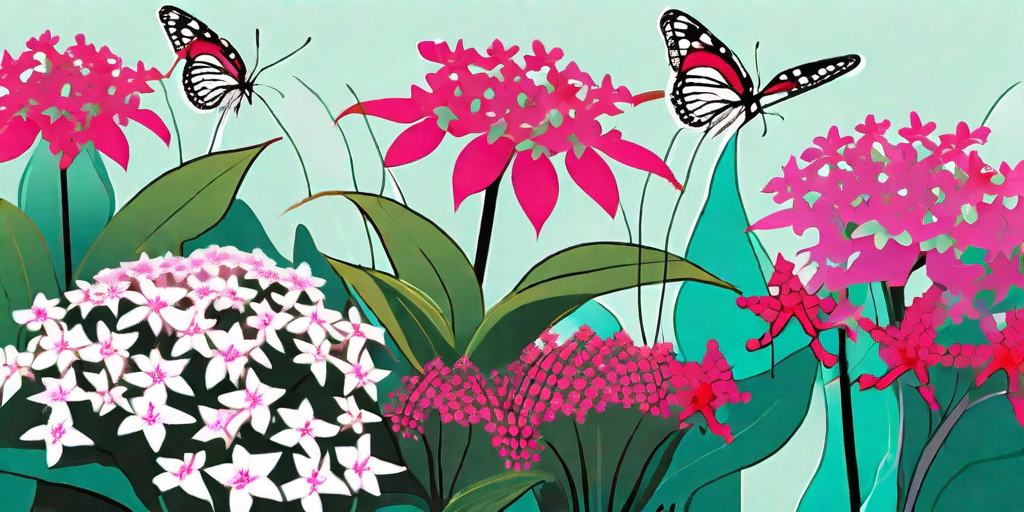
If you're looking for a way to add a pop of color to your garden without having to spend hours tending to it, then Pentas are the perfect solution for you. These vibrant, low-maintenance flowers are a gardener's dream come true. They are not only easy to care for, but they also attract butterflies and hummingbirds, adding an extra layer of beauty to your garden.
What are Pentas?
Before we dive into the nitty-gritty of how to grow and care for these beauties, let's first get to know them a bit better. Pentas, also known as Egyptian Star Cluster, are tropical flowering plants that are native to Africa and the Arabian Peninsula. They are known for their star-shaped flowers that come in a variety of colors, including white, pink, red, and lavender.
One of the unique characteristics of Pentas is their ability to bloom all year round in tropical and subtropical climates. This means that you can enjoy their vibrant colors and sweet nectar, which attracts butterflies and hummingbirds, throughout the year. Now, who wouldn't want that?
How to Grow Pentas
Growing Pentas is as easy as pie, or should we say, as easy as planting a seed. All you need is a sunny spot in your garden, well-drained soil, and a bit of patience. Here's a step-by-step guide on how to grow Pentas:
Step 1: Choose the Right Spot
Pentas love the sun. So, choose a spot in your garden that receives at least six hours of sunlight each day. If you live in a region with hot summers, a spot with afternoon shade would be ideal to protect the plants from scorching heat.
Step 2: Prepare the Soil
Pentas prefer well-drained soil. If your garden has heavy clay soil, consider amending it with compost or organic matter to improve its drainage. A slightly acidic to neutral pH is ideal for these plants.
Step 3: Plant the Seeds
Plant the Pentas seeds about 1/4 inch deep in the soil. Make sure to space them about 18 to 24 inches apart to give them enough room to grow. Water the seeds thoroughly after planting.
Step 4: Care for Your Pentas
Water your Pentas regularly, especially during dry spells. However, be careful not to overwater as this can cause root rot. Fertilize your plants every 4-6 weeks during the growing season to promote blooming.
Common Problems and Solutions
While Pentas are relatively low-maintenance, they can sometimes be affected by common garden pests and diseases. Here are a few problems you might encounter and how to deal with them:
Problem: Aphids
Aphids are small, soft-bodied insects that can cause damage by sucking the sap from the Pentas plants. If you notice a sticky substance on the leaves or a general decline in the plant's health, aphids might be the culprit.
Solution: You can control aphids by spraying the plants with a strong stream of water to knock the pests off. For severe infestations, consider using an insecticidal soap or neem oil.
Problem: Powdery Mildew
Powdery mildew is a common fungal disease that appears as a white powdery substance on the leaves. It can cause the leaves to yellow and drop off.
Solution: To prevent powdery mildew, make sure to water your Pentas at the soil level to avoid wetting the leaves. If the disease is already present, you can use a fungicide to control it.
Frequently Asked Questions
- Are Pentas perennials?
Yes, Pentas are perennials in zones 9-11. In colder climates, they can be grown as annuals. - Do Pentas attract butterflies?
Yes, the sweet nectar of Pentas flowers attracts butterflies, hummingbirds, and even bees. - How often should I water my Pentas?
Pentas prefer evenly moist soil. Water them regularly, especially during dry spells, but be careful not to overwater.
Conclusion
There you have it, folks! Pentas are the perfect addition to any garden. They're easy to grow, low-maintenance, and they add a vibrant splash of color to your garden. Plus, they attract butterflies and hummingbirds. What more could you ask for in a plant?
So, why wait? Get your hands dirty and start planting some Pentas today. Your garden (and the butterflies) will thank you!















